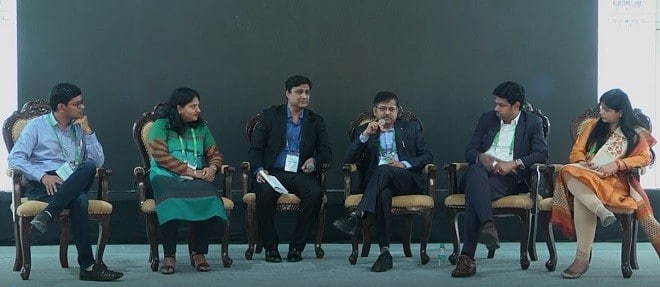- IoT landscape is huge, involving multiple partnerships across diverse areas.
- IoT startups often face challenges while looking for such partnerships with System Integrators (SIs).
- However, they need to be prepared to meet certain (and strict) expectations of the SIs.
- If successful, the end result is much more than what the startup had initially asked for.

When it comes to collaborating with companies heavily focused on system integration, IoT creators and startups often face challenges when they approach a System Integrator (SI) with whom they want to collaborate. Most of the time, these startups don’t meet up to the expectations of the SIs and end up getting rejected.
A panel discussion hosted by EFY at the IEW 2020 aimed to address these problems and come up with relevant solutions.
Speakers at the panel included Monika Gupta, Global 5G Engineering Lead, Capgemini; Ashish Khare, General Manager and Global Head IoT and Smart Cities, Wipro; Lokesh Payik, Chief of Digital Enterprise, Bosch; Saumitra Singh, CPO, TagBox Solutions and Amrita Chowdhury, Director, Gaia Smart Cities, and moderated by Sunil David, Regional Director – IoT (India and ASEAN), AT&T Global Network Services India Pvt. Ltd.
IoT has a huge ecosystem and requires multiple partners to come and work together. SIs on the panel have been involved in the following areas.
- IoT consulting and services, product engineering in areas like IIoT, automotive and medical.
- Digitisation of the industry (Industry 4.0).
- Smartening the supply chains.
- Traceability and quality compliance.
- Provide solution assurance to a customer.
“I believe 5G would be a very key leverage towards Industry 4.0 and bring digital transformation in the industrial world and also accelerate the industrial IoT,” said Monika Singh.
Challenges faced by many IoT startups
- Inability to understand the ground reality of working in a competitive environment.
- Logistics supply chain is quite complex and challenging. Very few startups address this issue as they do not fully understand it.
- Due to mixed experiences faced by SIs in the past, they are cautious about working with startups and taking them to a customer.
- Qualifying stringent requirements due to the criticality of certain industrial segments.
- Fear of a losing self-entity while working with a SI.
- Less amount of self-funding.
Expectations of SIs
- Patience, domain expertise and a customer’s interest are required.
- Startups can take advantage of the various programs offered by these SI companies at different levels, which offer incubation, guidance and scaling of their solutions for taking it to the market. They also allow certain solutions of a startup to be tested in a working plant of a SI company before taking it to the market as a “proof of scheme”.
- Have guts to take the losses of a customer upon your shoulder. Failures are a part of creating something new. Have a ready mindset for it.
- SI companies prefer to work with only OEM partners with ready solutions or startups with innovative solutions. Therefore, have a domain expertise well built into your team along with tech talents.
- Invest as much of your finances as possible when building a startup. It is valued by an SI company and shows the level of seriousness you have towards your own venture.
- SIs take a long time before testing and finalising a new solution. Therefore, have proper clarity with respect to your ideas before committing to a SI.
- Do not fear losing self-entity while working with an SI as they mostly work on a partnership basis, not on a “big brother” relationship.
“It’s important for startups to work with SIs and create an end solution to solve the problem of the customer; a customer doesn’t want to go to multiple people. That’s where the value stands out the best if startups work with SI’s, ” said Saumitra Singh.
“If IP is paid by a product developer, then it stays with him. If the customer has paid for it, then the customer owns it. In short, IP is owned by the person who pays for it,” said Ashish Khare.
Things to seriously avoid
- Don’t be an IoT startup for the sake of it. Find a genuine problem to solve and an efficient technological innovation.
- Avoid tampering/changing what is currently running. Manufacturing is a field where processes have been established over a period of time with stringent quality standards.
- Never go to a customer with a concept in mind. Always have a product in mind in order to avoid apprehension from a customer.
- SIs look forward to having deep and technical engagements before deciding to collaborate. Therefore, avoid open-ended conversations as they lead to nowhere.
- Don’t be a startup with a low work record before collaborating with an SI.
- Don’t go to an SI without having a client. If you do not have a client, you will be removed during the internal screening process.
“You need to be clear that you cannot take a customer for granted and never expect to get funded solely on the basis of your concept,” said Lokesh Payik.
Amrita Chowdhury further adds, “Have tangible problems at hand, have real clients at the end of the journey and then it’s a more direct and engaged conversation, where you can contribute and they can take us to places. It’s a win-win situation for both the parties.”
Results of these efforts
- Rigorous work helps to attain high customer satisfaction.
- Approaching a customer via a System Integrator (SI) equips one to effectively manage a client’s large logistics function.
- Leads to development of more enthusiastic and work-passionate startups. It can also lead to becoming a big IoT player in the manufacturing area and eventually become a partner for the customer.
- Taking advantage of the offered startup programs allows better co-innovation with the SI and the client, and hence leads to improved prototyping, piloting and scaling of the solution.










